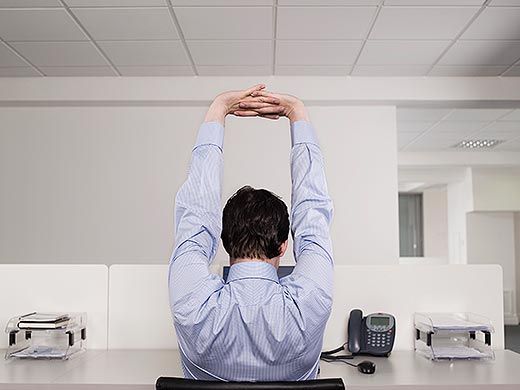Are Americans Stuck to their Cubicles?
After a debilitating bicycle accident kept her inactive, Mary Collins toured the country studying Americans’ sedentary lifestyle
/https://tf-cmsv2-smithsonianmag-media.s3.amazonaws.com/filer/employee-in-cubicle-stretching-631.jpg)
Writer Mary Collins had long been haunted by a statistic: more than 65 percent of American adults are overweight or obese, according to the Centers for Disease Control and Prevention, and most engage in moderate activity less than three times a week. To find out why we refuse to move, Collins embarked on a road trip that took her to an archeological dig in Kansas, the U.S. Olympic Center and the National Zoo, among other colorful destinations featured in her new book, “American Idle: A Journey Through our Sedentary Culture.” What she found changed her own approach to exercise and her understanding of how the rest of us live.
How did a former college athlete like you tune into in the plight of sedentary America?
I’ve never been sedentary all my life. But I had this devastating bicycle accident. I started to lose the use of my left leg and I had nerve damage. I was forced to live like the average American, walking less than a mile on average each day. It wasn’t something that I chose to do.
How did being sedentary change you?
I was absolutely stunned at how it impacted my life. I went into a depression, it affected my social life, it affected my energy levels, it affected my ability to focus for work. I thought, “Wow, everybody gives up so much vitality when they don’t move around, why do they live like this?" And I started out with a very judgmental, holier-than-thou attitude. Then I started actually researching the book and I saw that willpower is a very small part of the problem.
What’s the bigger problem?
Our society is set up to make it almost impossible to have people make healthy movement choices. We no longer integrate movement into our everyday lives. I began to realize that my book was really a cultural essay, and that health problems are actually symptoms of a much deeper fundamental social problem. We need to talk about how to empower people to integrate movement back into their world, just like they integrate food and sleep.
How should we go about integrating movement?
Simple things like an employer adding a shower at a location can increase activity levels of employees. People don’t have to worry about getting sweaty. They are more apt to bike to work, take a shower and get changed. If workers feel there is a safe outdoor walk or biking path near their work, they’re apt to be more active. If there’s a group of co-workers going every day, they are apt to go. It’s just very simple solutions. It’s not brain science. And that’s what’s frustrating.
Explain what you describe as humanity’s “physical legacy.”
Everything about our bodies springs from how we evolved to be hunter-gatherers. Not to be farmers. Not to be desk workers. But to be hunter-gatherers.
What about our bodies suggests that they’re meant for a life of movement?
We have so many sweat glands. We can go for hours, and days, if we constantly replenish with water. Another one is our lungs. We can alter our gait and control breathing at a different rate, which is awesome for long distance.
What is the significance of 3.7 miles in the history of human movement?
Scientists have looked at the few hunter-gatherer societies that are left, and in general there’s a three to four-mile daily range where you still gather enough calories to offset what you’re burning. All these national organizations today have different guidelines: move 30 minutes a day, or some say an hour. The bottom line is that anywhere between three and four miles a day seems to be a very healthy amount of light exercise and then you would of course supplement it with a dance class or swimming or basketball. That seems like a ton of walking for most Americans, and it is, because in most communities there aren’t sidewalks. But it’s a very modest physical activity level.
You spent some time with an Amish farmer?
What got me started on the book was a little item in the New York Times science section. A study had found that the average Amish farmer moved about 60 hours a week. Sixty hours of movement! Wow. So then I went out to Pennsylvania and visited an Amish farm several days in a row. And sure enough, at four in the morning, they’re up lugging buckets, collecting milk. After one day I was so tired.
Why did you visit an Utz potato chip factory?
I wanted to do a chapter about the social history of how we moved to a life where our work is no longer physical, and where our physical life is leisure, something we choose to do. That’s very recent. More than 40 percent of Americans still lived on farms in 1900. Now it’s something like 2 percent of people live on farms and most of them use big machines. That shift fascinated me. I thought, "How do I capture the essence of (modern) work?" Even the physical jobs that still exist are not healthy, because they are assembly line jobs. I ended up going to the potato chip factory because there was a bit of an irony that I would go talk about a book about movement at a potato chip factory.
How can we help the workers in that factory?
Places like Utz make sure their workers rotate jobs so the same person doesn’t do the same thing all day. To tell you the truth, the assembly line workers [are better off] than the desk workers. The desk workers relentlessly sit at their desk and type all day long. The average desk worker has far less variety of movement. A desk worker has a worst-case scenario. The repetition is even more intense.
Why have our athletes gotten so much more impressive over the years as the average American lags farther behind?
This stems out of the idea that exercise is something you choose to do—it’s somehow remote from our sense of self. [Professional athletes] are performers and entertainers now, separate from us, while the average person is less and less connected to physical life. Back when everyone was a farmer the divide between the farmer and the athlete really wasn’t that great. But now the divide between the overweight guy watching a football game and the star receiver playing the game is so tremendous that you’d think we were two different species.
Seven years after your bike accident, do you now enjoy a regular flow of physical movement?
I can’t play full court basketball anymore, which is probably a good thing, because I’m almost 49 and I probably would have blown out a knee or something. I try now to think about my vitality rather than fitness. I try to be a person who integrates levels of movements into my day that add energy to my life, that don’t wear my body down, that don’t wear me down, and yet they add to my strength. I still have slots for more rigorous activity every week—I’ll go for a pretty rigorous swim twice a week for 40 minutes, or I’ll run about a mile on a soft track and then go shoot some baskets for a total of about an hour—but those three assigned exercise slots are different from my movement agenda. At work I take the stairs—six or seven flights—about four times a day. I live in a very walk-able community. I walk to the library, walk to the movies, walk to the grocery store.
How will future generations approach exercise?
We’re in this real transition generation. My daughter, who is 17, is in that generation. She is the first person in my family to never know [a relative] who ever had a physical life. My grandfather worked in a lumberyard and was a farmer. He was a very physical guy. I had this model within a generation. My daughter lacks that. There is no model.
Some epidemiologists speculate that the next generation may have a shorter average life expectancy?
All the advances in medicine have stopped outdistancing lifestyle problems. But this generation is good at big-picture issues. When they see this as a larger social, cultural problem, not a sports and exercise problem, they’ll take it on and make it part of the agenda of the future.

